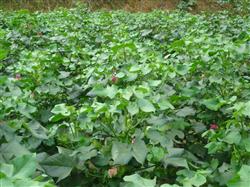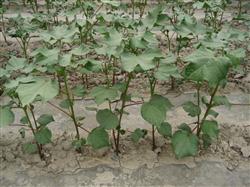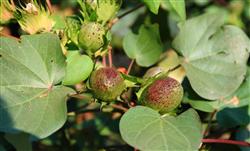How to manage cotton in the middle and later stage?

How to manage cotton in the middle and later stage? Please introduce the management methods of cotton in the middle and later stage, we can refer to the following methods for management: first, flower and boll stage management (1) re-application of flower and boll fertilizer, application of top fertilizer. Cotton usually blossoms around July 10. Fertilization at the flower and boll stage generally accounts for 50% of the topdressing amount during the growth period, and can be applied appropriately in advance (July 10-15). On the basis of applying sufficient base fertilizer or base fertilizer in the early stage, 40 kg of compound fertilizer with 15% content of nitrogen, phosphorus and potassium per mu, 20 kg of urea 15 kg, 20 kg of diammonium phosphate 15 kg, 10 kg of potassium chloride or formula fertilizer with the same content of nitrogen, phosphorus and potassium were applied per mu. In the cotton fields with insufficient application of flower and boll fertilizer or lack of fertilizer in the full flowering and boll setting stage, the application of capping fertilizer is beneficial to preserve the summer peach, increase the autumn peach and prevent premature senescence. 15 kilograms of urea will be recovered in early August, no later than the middle of August. The absorption capacity of root system decreased after boll blooming in high-yield cotton fields. In cotton fields with the trend of fertilizer deficiency, plant growth regulators or foliar fertilizers such as potassium dihydrogen phosphate or Lvzhifeng (Shuofeng 481) 15ml or Duoxifengchanling 10ml were sprayed twice with 30 kg water, which had obvious effect on increasing boll weight. (2) drought and waterlogging drainage. The flower and boll stage is sensitive to water, which is neither drought-resistant nor waterlogged, so it is necessary to meet the water consumption demand of cotton fields in time. As long as the high-yield cotton fields do not rain for 10 days, they should be irrigated timely. In general cotton fields, if the top leaves of cotton plants wilt at noon, they should be watered. When Rain Water is old, he should drain waterlogging in time. (3) cultivate the soil by ploughing. Before closing ridges in the cotton field at the early flowering stage, it should be combined with mid-tillage to cultivate the soil. It is beneficial to irrigation and drainage during the period of drought and waterlogging, and to prevent lodging in the later stage of high-yield fields. (4) pruning. Hit the top early at the right time, usually on July 15-20, and finish before July 25. Hit the side of the heart around August 10, no later than August 15. When the row spacing is more than 1.1 meters, keeping one leaf branch (slider) during pruning has the highest yield. Second, a series of chemical adjustments are mainly used in prosperous and long cotton fields, requiring a small number of times, mainly adjustment, and the combination of regulation and control. Spray at bud stage, early flowering stage and full flowering stage. Bud stage with Zhuangzhuangxue 4ml (or 0.5MUE 1g) with water 10mu 15kg; early flowering mu with Zhuangzhuangxue 10ml (or 1.5MUE 2.5g) with water 15mu 25kg; full flowering mu with Zhuzhuangsu 8MUE 12ml (or 2MUE 3g) with water 40kg, evenly sprayed. According to the situation of cotton seedlings, growth, cotton field fertility, Rain Water and other conditions, the dosage and times of zhuangzhuangsu and promethamine can be flexibly controlled. The concentration "would rather be low than high", "use fertilizer rather than thin, use waterlogging rather than drought, use water not dry". Third, there are many kinds of pests to control cotton pests, and aphids, cotton bollworms, cotton bugs and Bemisia Tabaci are the main types of cotton buds and bolls. 1. Cotton aphid. Summer aphids generally multiply from the first ten days of July to the first and middle of August. The sustained-release agent was prepared with 1 part of 40% omethoate EC and 6 parts of water, and smeared on the red-green junction of cotton seedling stem with cotton ball or brush. You can also use 40% omethoate 100 times solution, drop cotton heart leaf, small seedling drop 2 Mel 3 drops, big seedling drop 3 Mel 4 drops. Or spray 40% omethoate 1000 times or 3.6% aphid Luohan (cypermethrin, cypermethrin) 2000 times or 10% permethrin wettable powder 1500 times. 2. Cotton bollworm. At present, most of the cotton varieties planted in production are transgenic insect-resistant hybrid cotton, the second generation cotton bollworm does not need chemical control, and the third generation cotton bollworm is controlled twice according to the severity of occurrence. The spawning period was in late July and early August, with 4.5% cyhalothrin EC 25ml / 45ml mixed with 40 kg water or 35% Shachongke (phoxim, methomyl) 2000 / 3000 times or 12% cyhalothrin (cyhalothrin, methomyl) 1200 / 1500 times. The third generation eggs are mostly laid on the edge, and the liquid is concentrated on the sharp leaves and young buds to "break through on all sides". When using the above-mentioned insecticides, attention should be paid to the control of aphids and other bud and boll stage pests. All kinds of medications are used alternately. 3. Cotton blind bugs. Generally, the cotton field is the most harmful when it moves into the cotton field in the middle and late June. In addition to the combined control of cotton aphid and cotton bollworm, 4.5% focus (cypermethrin) 1500 Mel 2000 times liquid spray can also be used. 4. Bemisia Tabaci. In recent years, with the change of climate, the harm of Bemisia Tabaci is more serious. The adult began to lay eggs at 14.5 ℃, and the temperature was 21 ℃. The number of eggs laid increased with the increase of temperature. When Bemisia Tabaci occurred sporadically, 20% buprofezin wettable powder (1500 times) or 10% imidacloprid wettable powder (1500 times) was sprayed in the early stage, once every 10 days for 3 consecutive times. The mu is sprayed with 25% chlorpromazine, 50ml, 75g, 30ml, 40kg of water. Click to get more cotton planting technology click to get more food crop planting technology
- Prev

How should cotton be managed in the middle and later stages of planting?
How should cotton be managed in the middle and later stages of planting? Please give guidance on cotton management methods in the middle and later period, you can refer to the following methods: first, pruning management. For the luxuriant branches and leaves that have covered the whole cotton field, the old leaves, yellow leaves and empty branches without buds in the lower part of the main stem can be removed to achieve the effect of light transmission.
- Next

How to fertilize cotton in the middle and later stage?
How to fertilize cotton in the middle and later stage? Please introduce the cotton mid-harvest period can refer to the following methods of fertilization: first, increasing the application of cotton peach fertilizer is of great significance. August-September is the season for a large number of cotton peaches. In order to bear more peaches, bear large peaches, cover the waist of peaches and cover the top of autumn peaches, we must seize the opportunity to apply enough cotton and peach fertilizer. First.
Related
- The first cup of black tea in spring, the flavor and history of tea gardens in Kenya, Africa
- The computer can not only choose potatoes, but also grow tea rice. AI will grow winter oolong tea champion.
- It is not only the inflated tea bitten by insects, but also engraved with the four seasons tea in Beipu.
- The Oriental Beauty Tea Festival in Zhuxian County takes the stage at the weekend to experience the plus-size feast of oil tea.
- & quot; Oriental Beauty Tea & Exploration of Emei in Hsinchu, the hometown of quot;
- The new variety of strawberry "Tainong 1" dessert is the first choice with mellow aroma. Crimson gorgeous
- History of Tea in Taiwan: from Wild Inner Mountain to Export Tea Garden
- Two types of Taiwan Oriental Beauty Black Tea won the British three-Star Award for Childhood Tea Xiang Zhang Jiaqi changed from pilot to champion tea maker.
- Banana species and varieties: the planting history of Taiwan Xianren banana and dwarf banana is long, is banana disease resistant?
- Coffee planting Technology: Qianjie Coffee from Seedling to harvesting

